User Experience (UX) design plays a crucial role in the success of e-commerce websites. It encompasses everything from visual aesthetics to functionality and usability, ultimately shaping how users interact with an online store.
There are a variety of emerging design trends that are predicted to dominate the e-commerce landscape in 2024. As technology advances, new design trends emerge, paving the way for improved user experiences and more efficient e-commerce operations.
These design trends are not random or spontaneous; they evolve as a result of ongoing changes in user behavior, technological advancements, and market demands. By staying on top of these trends, you can create user-centric experiences that drive engagement, conversions, and revenue.
How Design Trends Evolve
Design trends often stem from innovations in technology. As developers create new tools and capabilities, designers find ways to incorporate these into their work to enhance UX. For example, the rise of mobile technology led to the ‘mobile-first’ design approach. Similarly, faster internet speeds have allowed the incorporation of motion graphics and video content, which were once too resource-intensive for many users.
It's important to remember that in these waves of trends, a lot of brands will copy designs from each other. The influence of competitors on one another is relevant in all industries: e-commerce is no expectation. There will always be brands that pave the way for others.
But all things considered, many emerging design trends can quickly become the expectation for consumers. As consumers become more tech-savvy, their expectations for online experiences increase. They demand seamless, intuitive interfaces that are visually appealing and easy to use, for example in how design evolution has followed from the waves of realism to more flat and minimalist designs. Following the expectations of consumers is often the best course of action, but it’s staying ahead of these expectations is where our attention is focused.
Ecommerce Design Trends for 2024
Design trends can be hard to predict, but when looking at what has come before and what is already taking off at the tail end of 2023, here are our predictions for e-commerce design trends you can expect to see in 2024.
1. Mobile-first
As smartphones continue to become more ingrained in our daily lives, mobile shopping is set to skyrocket even further. A significant part of this surge comes from in-app shopping on social media platforms. TikTok Shop, Instagram Shop, and the Shop app are prime examples, allowing brands to sell their products directly within the application. This eliminates friction in the buying process, effectively running a store within a platform where potential customers are already spending their time.
The advancement in mobile technology opens up exciting options for brands to explore. Which isn’t new for brands. However, it will continue to take focus as more and more users are shopping on their mobile devices rather than on desktops. Since late 2023, 54.58% of global web traffic has been through mobile devices, growing from just 17.02% from a decade ago.
2. Video Content
The video content is becoming increasingly important in the e-commerce space. Video proves to be more engaging than text alone and offers an effective way to demonstrate product features or services, making it an excellent tool for boosting conversion rates.
Not only is this useful for marketing, but also on product pages. Like on our friends Thread Wallets’ website for example. Their product videos help to illustrate a better example of sizing and what a product might look like in person than just an image.
3. Interactivity
Interactive design elements play an essential role in keeping the user interested and engaged while navigating a site. The rising trend in the gamification of websites, where brands can turn ordinary tasks into engaging experiences.
This can be seen in quizzes that brands use, creating a way to narrow down a customer's search to products that can be more relevant to their personal needs. This is a great way to integrate interactivity into UX design and increase conversion rates, as consumers gain a sense of personalization in their search for products that are right for them.
There has also been a surge in technologies such as augmented reality (AR) and virtual reality (VR) which have paved the way for immersive 3D visuals on websites and product pages. Specifically with Shopify, they have an incredibly useful “view in space” option that allows customers to view products live at home through AR. Along with Shopify’s 3D scanning tool on iOS, it’s easier than ever to create 3D assets on a website. For example, Lift Foil has done a great job of integrating 3D content into their product pages.
4. Artificial Intelligence
From personalized shopping recommendations to chatbots that provide superior customer service, AI and machine learning have significantly influenced UX design. AI has been proven to drastically improve customer experience and is rapidly becoming the norm in e-commerce to use.
It’s evident the future of UX design will see an even deeper integration of AI and machine learning in e-commerce design, with personalized user interfaces and predictive shopping experiences becoming a norm.
A great example of this can be seen with Siena AI, an autonomous customer service platform that uses AI specifically designed to express human empathy and understanding when communicating with customers. It reshapes the customer service experience from something automated to a more personal and more easy experience.
5. Keeping it simple
Now with all these new and exciting trends, it is important to remember to keep things SIMPLE. It is so easy to overload your website with every new and exciting design idea that emerges. But like many trends, they can move fast and become dated quickly.
This is why minimalism is taking over e-commerce design spaces, where less is more for consumers. Having a simple and concise UX design minimizes the possibility of distraction for site visitors, decreasing the chances of abandoning sites out of frustration or confusion.
Good design is not just about aesthetics; it's about constructing an enjoyable and effortless shopping experience that leads users to complete a purchase and return in the future. For example, making text easy to scan and not hiding key selling features in paragraphs of text.


